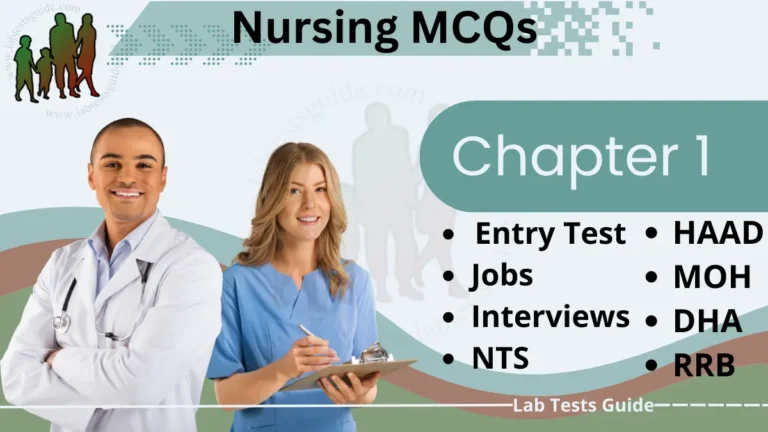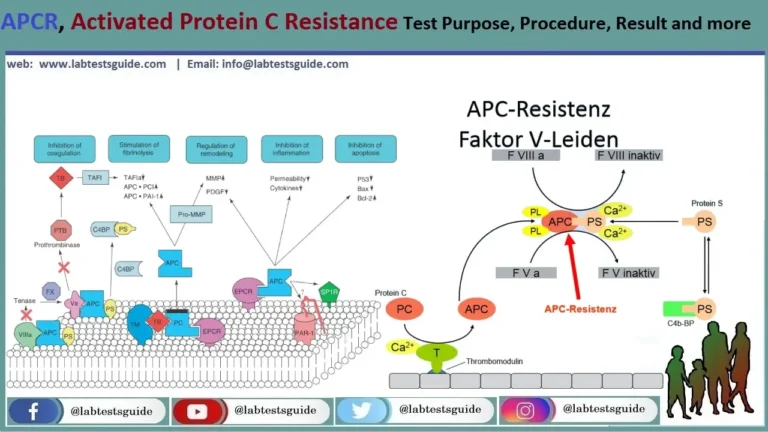7301 to 7350 MCQs for Lab Technician and Technologist Exam Preparation
5000 Plus MCQs for Lab Technician and Technologists are designed to test the knowledge and proficiency of laboratory professionals who work in the field of clinical laboratory science. These questions cover a wide range of topics related to laboratory science, including anatomy, physiology, microbiology, chemistry, and hematology.

If You like then share this to your friends and other social media.
If You have any question and suggestions then please Contact us Here
Questions 7301 to 7350
- Insulin receptor is a
- Monomer
- Dimer
- Trimer
- Tetramer ✔
- Tyrosine kinase activity is present in
- Acetylcholine receptor
- PDGF receptor ✔
- ADH receptor
- All of these
- Protein kinase C is activated by
- Cyclic AMP
- Cyclic GMP
- Diacyl glycerol ✔
- Inositol triphosphate
- Melatonin is synthesised in
- Hypothalamus
- Posterior pituitary gland
- Pineal gland ✔
- Melanocytes
- Melatonin is synthesised from
- Phenylalanine
- Tyrosine
- Tryptophan ✔
- None of these
- Melanocyte stimulating hormone is secreted by
- Pineal gland
- Anterior lobe of pituitary gland
- Posterior lobe of pituitary gland
- Intermediate lobe of pituitary gland ✔
- MSH causes
- Dispersal of melanin granules in melanocytes ✔
- Increase in melanin concentration in melanocytes
- Decerease in melanin concentration in melanocytes
- Increase in number of melanocytes
- Secretion of MSH is regulated by
- Feedback mechanism
- Melatonin
- Hypothalamic hormones✔
- ACTH
- A hormone synthesised in the hypothalamus is
- Melatonin
- Melanocyte stimulating hormone
- Vasopressin ✔
- Prolactin
- Posterior pituitary gland secretes
- Catecholamines
- Oxytocin ✔
- Follicle stimulating hormone
- Serotonin
- A nonapeptide among the following is
- Antidiuretic hormone ✔
- Insulin
- ACTH
- Thyrotropin releasing hormone
- Diabetes insipidus is caused by deficient secretion of
- Insulin
- Glucagon
- Vasopressin ✔
- Oxytocin
- Peripheral vasoconstriction is caused by high concentrations of
- Antidiuretic hormone ✔
- Melatonin
- Glucagon
- Oxytocin
- Somatotropin is secreted by
- Hypothalamus
- Anterior pituitary ✔
- Posterior pituitary
- Thyroid gland
- Secretion of Insulin-like Growth Factor-I is promoted by
- Insulin
- Glucagon
- Growth hormone ✔
- Somatomedin C
- Growth hormone increases
- Protein synthesis ✔
- Lipogenesis
- Glycogenolysis
- All of these
- Secretion of growth hormone is inhibited by
- Somatomedin C
- Somatostatin
- Feedback inhibition
- All of these✔
- Secretion of somatotrophin is promoted by
- Somatomedin C
- Somatostatin
- Growth hormone releasing hormone ✔
- Hypoglycaemia
- Human growth hormone has
- One polypeptide chain and one intra-chain disulphide bond
- One polypeptide chain and two intra-chain disulphide bond ✔
- Two polypeptide chains joined by one disulphide bond
- Two polypeptide chains joined by two disulphide bond
- Number of amino acid residues in human growth hormone is
- 51
- 84
- 191 ✔
- 198
- Number of amino acid residues in prolactin is
- 51
- 84
- 191
- 199 ✔
- Secretion of prolactin is regulated by
- Feedback inhibition
- Prolactin releasing hormone
- Prolactin release inhibiting hormone
- All of these ✔
- Precursor of ACTH is
- Cholesterol
- Pregnenolone
- Corticotropin
- Pro-opiomelanocortin ✔
- All of the following can be formed from pro-opiomelanocortin except
- α-and β-MSH
- β-and γ-Lipotropins
- α-and β-Endorphins
- FSH ✔
- All the following statements about proopiomelanocortin are true except
- It is made up of 285 amino acids
- It is synthesised in pars intermedia and anterior lobe of pituitary gland
- It is the precursor of ACTH and melatonin ✔
- I t is the precursor of corticotropin like intermediate lobe peptide and endorphins
- All the following statements about ACTH are true except
- It is a tropic hormone
- Its target cells are located in adrenal cortex
- Its receptors are located in the cell membrane
- Its second messenger is inositol triphosphate ✔
- Regulation of ACTH secretion occurs through
- Corticotropin releasing hormone (CRH) and corticotropin release inhibiting hormone (CRIH) of hypothalamus
- Feedback inhibition by cortisol
- CRH and feedback inhibition by cortisol ✔
- CRIH and feedback inhibition by cortiso
- ACTH is a polypeptide made up of
- 39 amino acids ✔
- 41 amino acids
- 51 amino acids
- 84 amino acids
- CRH is a polypeptide made up of
- 39 amino acids
- 41 amino acids ✔
- 51 amino acids
- 84 amino acids
- All the following statements about TSH are true except
- It is a glycoprotein
- It is made up of α- and β-subunits
- Receptor recognition involves both the subunits
- Its subunit is identical with those of FSH and LH ✔
- All the following statements about TSH are true except
- It is a tropic hormone
- It acts on para-follicular cells of thyroid glands ✔
- Its receptors are membrane-bound
- Its second messenger is cyclic AMP
- All the following statements about thyrotropin releasing hormone are true except
- It is secreted by hypothalamus
- It is a pentapeptide ✔
- It increases the secretion of TSH
- Its secretion is inhibited by high level of T3 and T4 in blood
- In males, luteinising hormone acts on
- Leydig cells ✔
- Sertoli cells
- Prostate gland
- All of these
- All the following statements about FSH are true except
- It is a tropic hormone secreted by anterior pituitary
- Its secretion is increased by gonadotropin releasing hormone
- It acts on Sertoli cells
- It increases the synthesis of testosterone ✔
- In males, secretion of luteinising hormone is inhibited by
- Gonadotropin releasing hormone
- FSH
- High blood level of testosterone ✔
- Inhibin
- Secretion of luteinising hormone is increased by
- GnRH ✔
- FSH
- Testosterone
- None of these
- In structure and function, HCG resembles
- FSH
- LH ✔
- GnRH
- Progesterone
- Acromegaly results from overproduction of
- ACTH during childhood
- TSH during adult life
- Growth hormone during childhood
- Growth hormone during adult life ✔
- Acromegaly results in all the following except
- Overgrowth of the bones of face, hands and feet
- Increased stature ✔
- Enlargements of viscera
- Impaired glucose tolerance
- Overproduction of growth hormone during childhood causes
- Acromegaly
- Gigantism ✔
- Cushing’s disease
- Simmond’s disease
- Decreased secretion of growth hormone during childhood causes
- Simmond’s disease
- Cushing’s disease
- Dwarfism✔
- Cretinism
- Stature is increased in
- Gigantism✔
- Acromegaly
- Simmond’s disease
- Cushing’s disease
- An amino acid used for the synthesis of thyroid hormone is
- Tyrosine ✔
- Tryptophan
- Histidine
- Proline
- An enzyme required for the synthesis of thyroid hormones is
- Iodinase
- Deiodinase
- Thyroperoxidase ✔
- Thyroxine synthetase
- Thyroperoxidase iodinates
- Free tyrosine in thyroid gland
- Tyrosine residues of thyroglobulin ✔
- Tyrosine residues of thyroxine binding globulin
- Tyrosine residues of thyroxine binding prealbumin
- In thyroxine, tyrosine residues are iodinated at positions:
- 1 and 3
- 2 and 4
- 3 and 5 ✔
- 4 and 6
- Thyroid gland takes up circulating iodine
- By simple diffusion
- By facilitated diffusion
- By active uptake ✔
- In exchange for chloride
- Thyroid hormones are present in blood
- In free form
- In association with thyroxine binding globulin (TBG)
- In association with thyroxine binding prealbumin (TBPA)
- Mainly in association with TBG, partly in free form and sometimes in association with TBPA also✔
- When thyroxine binding globulin and thyroxine binding pre-albumin are saturated with thyroxine, the excess hormone is transported by
- Albumin ✔
- Gamma globulins
- Transcortin
- None of these
- Receptors for thyroid hormones are present
- On the cell membrane
- Across the cell membrane
- Inside the cells ✔
- In association with G-proteins
The questions are typically designed to assess the technical skills and knowledge required for the laboratory profession, including the ability to analyze laboratory test results, perform laboratory procedures, and maintain laboratory equipment.
To prepare for these MCQs, candidates should have a thorough understanding of the key concepts and principles of laboratory science. They should also be familiar with common laboratory equipment and procedures, as well as laboratory safety protocols.
Candidates may also benefit from studying specific laboratory science textbooks or taking online courses that cover the material tested in the MCQs. Additionally, practicing sample MCQs and reviewing the answers can help candidates identify areas where they may need to improve their knowledge or skills.
Overall, the MCQs for lab technologists are designed to be challenging and comprehensive, requiring candidates to demonstrate a high level of proficiency in the field of laboratory science.
Possible References Used






